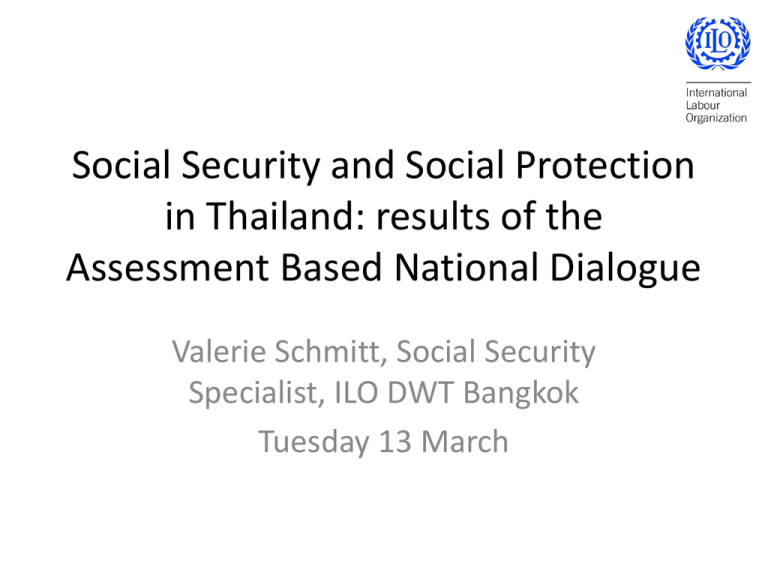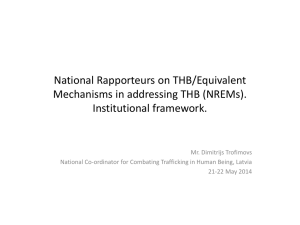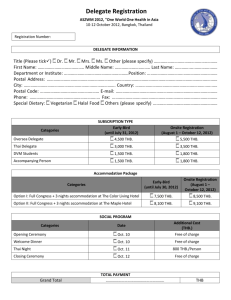Social Security and Social Protection in Thailand: results of the
advertisement

Social Security and Social Protection in Thailand: results of the Assessment Based National Dialogue Valerie Schmitt, Social Security Specialist, ILO DWT Bangkok Tuesday 13 March Structure of the presentation • Definition of the SPF • Purpose and process of the Assessment • From situation analysis to recommendations • The costing using the RAP protocol • Remaining questions… The SPF is the first step towards higher levels of social protection Level of CSMBS (7% coverage population) SSS (15% population) NSF for informal economy workers SSS for informal economy workers UCS & 500 Baht scheme Poor - Informal economy - Form. Sect. The Social protection floor is not only a set of measures to provide income replacement A mechanism to: • Protect people from poverty through a guarantee of income security • help people meet their basic needs • & develop individual capabilities A mechanism providing protection against the financial consequences of risks (9 contingencies) In a country with the Social protection floor All residents have access to essential health care All children enjoy income security through transfers in cash or kind access to nutrition, education and care All those in active age groups who cannot earn sufficient income enjoy a minimum income security (transfer in cash or in kind & employment guarantee schemes) All residents in old age and with disabilities have income security through pensions or transfers in kind Many elements of the SPF are already here in Asia Relevance, South South India: RSBY, NREGA Cambodia: CARD’s NSPS with clear reference to the SPF … including HEFs, CBHIs, Food distribution, PWPs,… Thailand: UC scheme, minimum pension scheme (500 THB) Indonesia: Jamkesmas, Jampersal, PKH, Rice for the poor, PNPM China: minimum living standard guarantee program; new rural corporative medical care (NRCMC); health insurance for urban uninsured residents (HIUR); rural old-age pension Lao: extension of SHP for all Philippines: 4Ps Vietnam: 10 years Social security strategy Structure of the presentation • Definition of the SPF • Purpose and process of the Assessment • From situation analysis to recommendations • The costing using the RAP protocol • Remaining questions… The Assessment = is the SPF a reality? Full achievement of the SPF !! Still some gaps to reach the SPF… The assessment tells us 1. What is the situation? For each guarantee of the SPF we describe existing schemes, laws, regulations 2. How far are we from the SPF? We compare what exist with the SPF framework 3. What should we do to achieve the SPF? We draw recommendations and propose new (or extended) social protection provisions Has all the population access to health care and income security? Are the benefits adequate? The assessment tells us 4. How much will it cost? We calculate the cost of the additional SPF provisions using the RAP protocol and compare with government budget Beyond the assessment 5. How to finance the new SPF provisions? We complete the assessment with recommendations to increase the fiscal space 6. What will be the return on investment? We complete the assessment with an analysis of the impact of the SPF provisions on poverty The results can be summarized in the Assessment matrix Who conducted the assessment? SPF-Initiative 17 UN agencies International NGOs (Help Age) Governments (France, Luxembourg, etc.) In Thailand SPF-Team in Thailand Ministries CSOs NESDB, MSDHS, MoL, MoH, MoF, MoE, MoI Help Age, Home Net, SOSOSO ILO, WHO, UNICEF, UNFPA, UNWOMEN, UNESCO LINK WITH UNPAF ON SOCIAL PROTECTION Academia HISRO & TDRI The Assessment has three steps JUN JUL AUG SEP OCT NOV DEC JAN FEB MAR STEP 1 – From situation analysis to recommendations 1.1 Inventory of schemes, gaps, issues 1.2 Provision of Recommendations STEP 2 - Costing 1 10 August0 A u 2.1 Translation of recommendations into “costable” scenarios 2.2 Data collection (I) on POP, ECO, EAP, parameters for each scenario and projection of the costs using the RAP protocol 2.3 Preliminary results of the costing 30 November 2.4 Data collection (II) on GGO, ECO and finalization of the costing 2.4 Recommendations from CSOs 2.5 Validation workshop 23 February 16 March STEP 3 – Finalization 3.1 Writing assessment report 3.2 Presentation to the Government? X Structure of the presentation • Definition of the SPF • Purpose and process of the Assessment • From situation analysis to recommendations • The costing using the RAP protocol • Remaining questions… Assessment of Health care Existing provisions Main design gaps Implementation issues CSMBS (7% population) Fragmented systems and laws Exclusion from UCS (ethnic minorities, stateless) because of no ID or lack of information Dependents are not covered by SSS SSO (15%) UCS (76%) Compulsory Migrant Health Insurance for registered migrant workers (migrants under MOU or who have completed the National Verification Process are entitled to the SSS) Vertical inequality (same package UCS-SSS) Undocumented Migrant workers are not covered (they represent 2-3 Mo or 5% of the workforce) Inequity in access to ARTs (CSBMS VS UCS) Confidentiality/stigma issues (HIV-AIDS) Geographic imbalances: poor availability of HC supply in some area, idem for HIV Exclusion of migrant workers from SSO because of non declaration by employer Assessment of Health care The floor is achieved for Health Care, although implementation issues remain Main recommendations: Future work? Reduce fragmentation (the way the system is organized, financed, regulated) HISRO/TDRI proposal to reduce fragmentation, ensure financial sustainability and increase the fiscal space Ensure financial sustainability of the system Introduce news measures such as the necessity to co-pay for non essential services Improve health care supply, HIVsensitiveness of the whole system, Long Term care (aging society) Organizational and legal reviews Feasibility study on long term care (ILO-HISRO collaboration?) Income security for children Existing provisions Main design gaps Implementation issues Child allowance introduced in 1998 for formal workers by Social Security Scheme Around 5-6 million children of informal economy workers do not receive adequate assistance – need to cover e.g. transportation costs Some children from migrant workers and ethnic communities in remote areas have limited access to education Free education for all (15 years) Scholarships (civil servants, poor households, social activists) Free school meals and other support in kind (bicycles…) Improve services for preschool children (stimulation of child development) Regional disparities in quality of education, esp. in rural areas Leakages / corruption issues in food distribution Lack of information limiting access to services Income security for children Need to establish a child allowance for all children 0-6, improve quality of education and care for pre-school children Main recommendations: Future work? Design and implement a child allowance for all children 0-3, 0-6 or 0-12 years old Costing of the Child allowance using the RAP protocol (and NESDB demographic data) Add a family benefit under Benefit package for Article 40 Provide systematic financial/in kind support to poor students & children (and not ad hoc) Improve the quality of the services (education, child care, services for mothers and children) Feasibility study for the design and implementation of the Child allowance once the idea is endorsed Income security for working age Existing provisions Main design gaps Implementation issues Compulsory insurance (art. 33): Sickness, maternity, invalidity, death, child allowance, old-age pension and unemployment under SSF // work injury under WCF Fragmented schemes increased admin burden Compliance issues: some employers collect the contributions for SSS but do not register their workers Voluntary Insurance (art. 39): Sickness, maternity, invalidity, death, child allowance and old-age pension (432 THB/m) Voluntary Subsidized Insurance (art. 40- IE workers): 2 packages (i) sickness, invalidity, death (ii) Idem + old-age (lump sum) No portability between schemes Some categories of workers are excluded from Art 33 (ex. domestic workers) Package for informal economy workers is not attractive Migrant workers have to leave 7 days after dismissal (no UI) and in case of disability Income security for working age Existing provisions Main design gaps 500 baths transfer for people with disabilities from MSDHS administered at TAO level and life quality fund (in kind by providing equipment) Cumulated with 500 Baht old age allowance although both aim at the same purpose (income replacement in case people are no longer able to work) 500 baths transfer for people with HIV-AIDS from MoL administered at TAO level Funeral expenditure (MSDHS) Ad hoc support 2000 Baths up to 3 times a year (on demand) implemented by MSDHS Ad hoc support TVET Migrants excluded Implementation issues Not adapted to market needs Income security for working age Reduce exclusions under Art. 33 and 40 - Reduce social evasion Social assistance should be more predictable/less ad hoc Linkages between SP and employability need to be explored Main recommendations: Future work? Review social assistance schemes in place to ensure income support to inf. eco. workers Design combined packages including income support and mechanisms to increase employability and/or access to markets Develop an objective and standardized poverty and vulnerability assessment system Review existing schemes (Art 33 and 40) in order to cover more people, with more adequate benefits (e.g. home workers, domestic workers) Explore linkages between social protection with Employment to ensure graduation Feasibility studies on extension of existing schemes (Art 33 and 40) Explore the PEOPLE service at decentralized level Awareness raising Income security for elderly Existing provisions Main design gaps Implementation issues Civil servants - Government Pension Scheme, Provident Funds for State Owned enterprises, Private Teacher Aid Fund No portability across schemes Implementation of the 500 THB scheme politicized at TAO level Formal sector workers - SSF Art 40: contribution not enough to guarantee income support Voluntary insurance under Art 39 and Art 40 (package 2 – lump sum) Schemes with Lump sum: income support not guaranteed National Savings Fund (MoF) for Thai Nationals aged 15-60 not benefiting from government or SSF No indexation of the social pension in legislation Universal Non contributory 500 THB scheme Difficult contribution to NSSF (irregular income) Tax exemption does not benefit the poorest Registration under schemes mainly possible in BKK and long admin procedures Ad hoc community volunteer care giver program (MSDHS) Income security for elderly Reform 500 THB scheme : increase level of benefits, legislate Improve coherence and portability between the schemes Look at Long Term care Main recommendations: Future work? Increase level of benefits to poverty line (at least) and index benefits Feasibility study of long term care Legislate the 500 THB scheme to ensure predictability Costing of social pension at level of food poverty line + additional benefits depending on level of dependency Establish long term care system holistic care to the elderly Create a coherent pension system (& portability) and look at tax reform to ensure financial sustainability of the scheme Take away message • The Assessment exercise – Provides a snapshot of what exist for each of the four guarantees of the SPF – Identifies gaps and issues for each guarantee – leads to the formulation of some policy recommendations – what should we do to improve the situation and complete the social protection floor? • To push these recommendations we need to know: – (1) how much they cost? – (2) what will be their impact (on poverty, employment…)? – (3) where we will find the money? • The RAP protocol can help us answering the first question (for some simple recommendations – not all of them) Structure of the presentation • Definition of the SPF • Purpose and process of the Assessment • From situation analysis to recommendations • The costing using the RAP protocol • Remaining questions… Assessment matrix including list of recommendations Recommendations = Increase benefits or population covered, introduce new benefits We can use the RAP Protocol LABOUR MARKET MODEL GENERAL GOVERNMENT OPERATIONS MODEL MACROECONOMIC MODEL BENEFITS COSTING EXERCISE SUMMARY AND RESULTS DEMOGRAPHIC FRAMEWORK Qualitative recommendations on the management of existing schemes, review targeting & registration mechanisms, review the law, conduct research, conduct a tax reform… We need to conduct complementary studies From recommendations to scenarios • The recommendation: “Design and implement cash transfers for all children” several scenarios: “Universal child allowance” Scenario 1: for all children aged 0-3 (THB 400/month) Scenario 2: for all children aged 0-6 (400 THB/month) Scenario 3: for all children aged 0-12 (400 THB/month) Scenario 4: for all children aged 0-6 (500 THB/month) Scenario 5: for all children aged 0-12 (500 THB/month) To calculate the cost of the scenario 1Universal allowance for all children aged 0-3 years old (THB 400/month) Which information do we need? To calculate the cost of the scenario 1Universal allowance for all children aged 0-3 years old (THB 400/month) I need: The number of children 0-3 years old in 2011 and the projected number in 2012… 2020 The % who will be covered in 2012, 2013… The amount of benefit in 2012 (400 THB/month) and its value in 2013, 2014… (indexation with inflation) The % of administrative cost of the child allowance To calculate the cost of the scenario 1Universal allowance for all children aged 0-3 years old (THB 400/month) Demographic changes 2012 2013 Number of children 0-3 years old 3,055 3,135 Percentage covered 50% 80% Amount of benefits (THB/year) 4800 4920 % of Admin costs 5% 5% Inflation Total cost 50% * 3,055,000* 4800 * 1.05 To calculate the cost of the scenario 1Universal allowance for all children aged 0-3 years old (THB 400/month) Total cost 50% * 3,055,000* 4800 * 1.05 = 7,698 million THB In % of GDP = 0.07% In % of Government Expenditure To calculate the cost of the scenario 1Universal allowance for all children aged 0-3 years old (THB 400/month) I know that: I need the following models: The number of children will change Demographic projections Level of the child allowance (FS) will change with inflation Percentage of GDP and Government Expenditure Inflation forecasts GDP and Government Expenditures forecasts 1- Data collection GENERAL GOVERNMENT OPERATIONS MODEL LABOUR MARKET MODEL MACROECONOMIC MODEL BENEFITS COSTING EXERCISE 2- Transformation of the recommendations into scenarios SUMMARY AND RESULTS Calculation of the cost in 2011 of each scenario, Projection over the years of this cost, in THB, % Govt expenditure and % GDP DEMOGRAPHIC FRAMEWORK Scenarios and results – Children Scenario 1: for all children aged 0-3 (THB 400/month) allowance allTHB/month) children Scenario 2:Universal for all children aged 0-6for (400 Scenario 3: for all children aged 0-12 (400 THB/month) Scenario 1: aged (THB 400/month) = 0.09% GDP in 2020 Scenario 4: for0-3 all children aged 0-6 (500 THB/month) Scenario 2: aged (400 THB/month) 0.16% GDP in 2020 Scenario 5: for0-6 all children aged 0-12=(500 THB/month) Scenario 3: aged 0-12 (400 THB/month) Scenario 4: aged 0-6 (500 THB/month) Scenario 5: aged 0-12 (500 THB/month) Between 0.09% and 0.36% of GDP in 2020 Scenarios and results – Maternity benefit for female IE workers • A maternity benefit to compensate for the loss of income immediately after delivery. Lump sum payment of 4,500 THB paid upon delivery. Which information do we need? Scenarios and results – Maternity benefit for female IE workers • A maternity benefit to compensate for the loss of income immediately after delivery. Lump sum payment of 4,500 THB paid upon delivery. Number of births from IE workers Percentage covered (50% the first year…) Amount of benefits (THB/year) % of Admin costs Scenarios and results – Maternity benefit for female IE workers Only 0.01% of GDP in 2020 The other scenarios • For the elderly, benefit to compensate for the loss of income after 60 years old, including a “Long term care” component: – 600 THB/month for 60-69 years old – 700 THB/month for 70-79 years old – 800 THB/month for 80-89 years old – 1,000 THB/month for 90 years and over The other scenarios • For the working age, several schemes to compensate for the loss of income in case of sickness or disability: – 200 THB/day in case of sickness (similar to Article 40 for informal economy workers) – 1,000 THB/month in case of severe disability (higher than existing scheme of 500 THB/month) The other scenarios • For the working age, a number of anti-poverty and training programs : AntiIncreasing productivity component poverty Pre and Lower Upper Vocational Higher component primary secondary secondary training education school school school Poor 200 baht/day Non Poor N/A 20 days 20 days 20 days 10 days N/A 20 days 20 days 20 days 10 days One training per five years (20% per year) Cost of training = 550 THB/person/day N/A Estimated cost of achieving the SPF 2012 2013 2014 2015 2020 Child benefit-Scenario Min Universal pension 500BHT Disability allowance Maternity allowance Working Age Total in % of GDP Total in % of Govt Revenues 1,591 43,162 218 740 50,442 0.8% 6% 1,972 47,321 228 1,239 50,877 0.8% 6% 2,353 51,880 240 1,618 51,219 0.8% 7% 3,126 56,855 250 1,687 51,516 0.7% 7% 7,865 69,836 307 2,073 52,867 0.6% 4% Child benefit-Scenario Max Universal pension-ladder with indexation Disability allowance 34,324 55,085 70,014 70,932 77,625 59,182 218 66,584 228 74,889 240 84,375 250 118,813 307 Maternity allowance Working Age Total in % of GDP Total in % of Govt Revenues 740 50,442 0.9% 7% 1,239 50,877 0.9% 7% 1,618 51,219 0.9% 8% 1,687 51,516 0.9% 8% 2,073 52,867 0.8% 6% Take away message • The RAP gives a first idea of “how much it would cost” to complete the SPF • It tells us whether this is affordable or not • It helps to decide whether or not we should implement the proposed scheme • It can be completed with poverty impact analysis, and analysis of the impact on employment of some of the measures for working age population • It needs to be completed by comprehensive feasibility studies and fiscal space analysis Structure of the presentation • Definition of the SPF • Purpose and process of the Assessment • From situation analysis to recommendations • The costing using the RAP protocol • Remaining questions… Remaining questions • How to finance? Additional taxes? – A question for the Fiscal policy office of the Ministry of Finance… but also for the national commissions… • What will be the return on investment? – Impact on poverty reduction, reduction of inequalities, social inclusion, access to employment, increase in productivity • How to move forward? – Role of national commissions (House of Senate and Parliament)?? • How to implement these measures? – Role of the civil society, the local administration at TAMBON level, the committees at local level in the implementation and oversight of the extension of the SPF? Remaining questions Reducing costs by sharing admin functions & information MoH MoE MoL Reducing fragmentation with a single entry point MoI … Monitoring the extension of SP coverage at central level and assessing the impact Case management= providing adapted services/benefits Representing the interests of the beneficiaries, ensuring that the SPF is a reality Offering combined benefit packages with a bigger impact on poverty reduction (e.g. access to health, training, etc.) Committees? Local administration? CSOs? MSD HS






